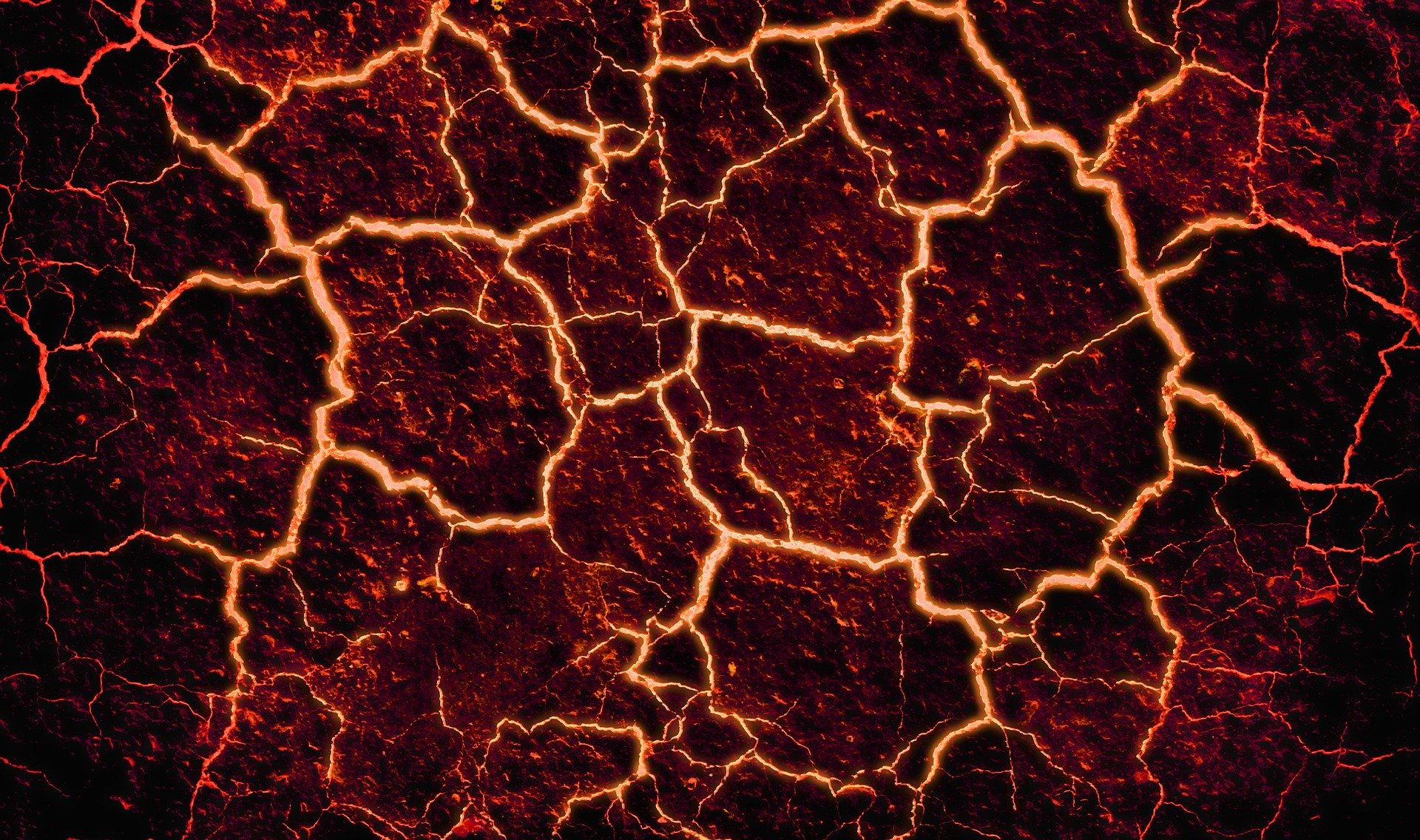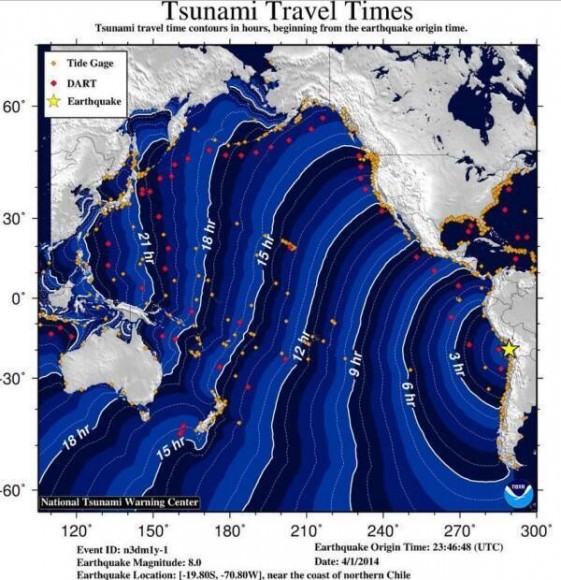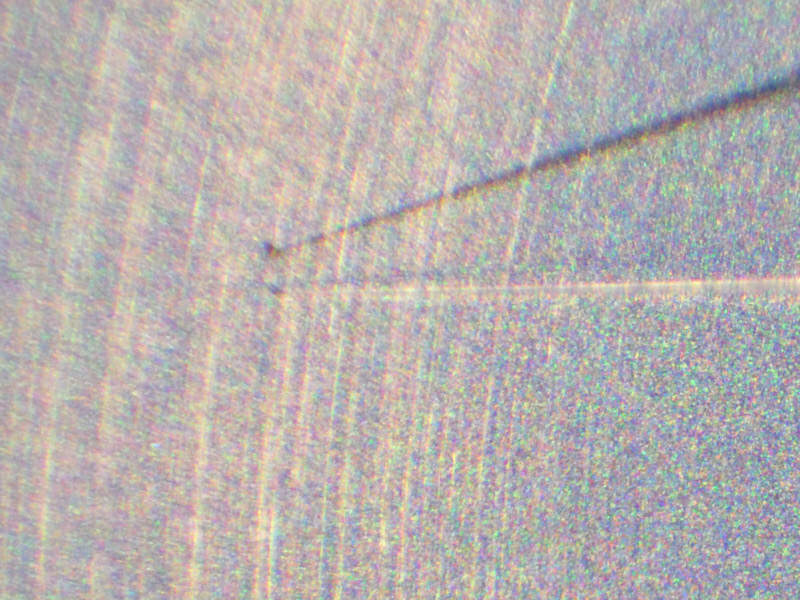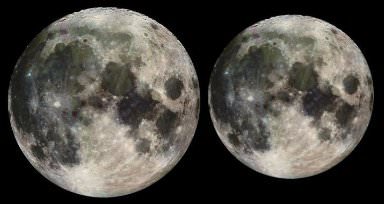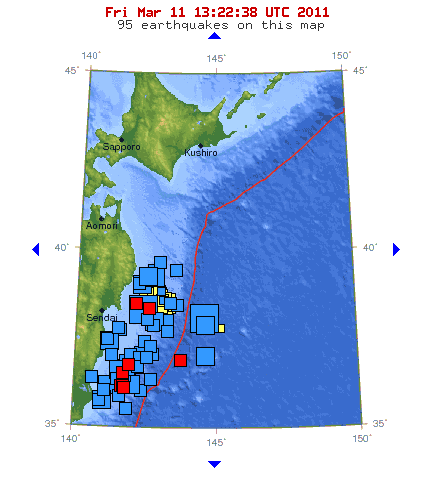As the COVID-19 disease continues to wreak its viral havoc on the human population of Earth, governments around the world have closed their schools, shut down non-essential businesses, and told their citizens to stay at home as much as possible. In other words, there’s a lot less human activity on our planet, and it’s led to a detectable drop in seismic activity.
Continue reading “Thanks to COVID-19, nothing’s moving, and seismologists can tell”What is the Pacific “Ring of Fire”?

What if someone were to tell you that there’s a region in the world where roughly 90% of the world’s earthquakes occur. What if they were to tell you that this region is also home to over 75% of the world’s active and dormant volcanoes, and all but 3 of the world’s 25 largest eruptions in the last 11,700 years took place here.
Chances are, you’d think twice about buying real-estate there. But strangely enough, hundreds of millions of people live in this area, and some of the most densely-packed cities in the world have been built atop its shaky faults. We are talking about the Pacific Ring of Fire, a geologically and volcanically active region that stretches from one side of the Pacific to the other.
Definition:
Also known as the circum-Pacific belt, the “Ring of Fire” is a 40,000 km (25,000 mile) horseshoe-shaped basin that is associated with a nearly continuous series of oceanic trenches, volcanic arcs, and volcanic belts and/or plate movements. This ring accounts for 452 volcanoes (active and dormant), stretching from the southern tip of South America, up along the coast of North America, across the Bering Strait, down through Japan, and into New Zealand – with several active and dormant volcanoes in Antarctica closing the ring.
Tectonic Activity:
The Ring of Fire is the direct result of plate tectonics and the movement and collisions of lithospheric plates. These plates, which constitute the outer layer of the planet, are constantly in motion atop the mantle. Sometimes they collide, pull apart, or slide alongside each other; resulting in convergent boundaries, divergent boundaries, and transform boundaries.

In the case of the former, subduction zones are often the result, where the heavier plate slips under the lighter plate – forming a deep trench. This subduction changes the dense mantle into buoyant magma, which rises through the crust to the Earth’s surface. Over millions of years, this rising magma creates a series of active volcanoes known as a volcanic arc.
These ocean trenches and volcanic arcs run parallel to one another. For instance, the Aleutian Islands in the U.S. state of Alaska run parallel to the Aleutian Trench. Both geographic features continue to form as the Pacific Plate subducts beneath the North American Plate. Meanwhile, the Andes Mountains of South America run parallel to the Peru-Chile Trench, created as the Nazca Plate subducts beneath the South American Plate.
In the case of divergent boundaries, these are formed when tectonic plates pull apart, forming rift valleys on the seafloor. When this happens, magma wells up in the rift as the old crust pulls itself in opposite directions, where it is cooled by seawater to form new crust. This upward movement and eventual cooling of this magma has created high ridges on the ocean floor over millions of years.
The East Pacific Rise is a site of major seafloor spreading in the Ring of Fire, located on the divergent boundary of the Pacific Plate and the Cocos Plate (west of Central America), the Nazca Plate (west of South America), and the Antarctic Plate. The largest known group of volcanoes on Earth is found underwater along the portion of the East Pacific Rise between the coasts of northern Chile and southern Peru.
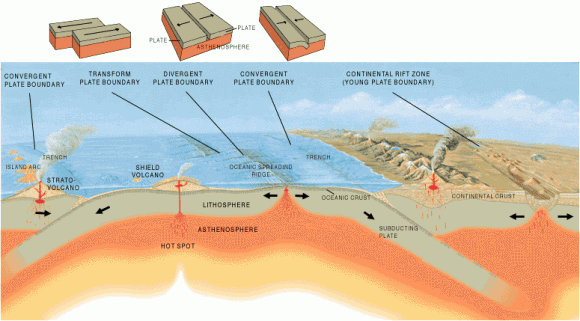
A transform boundary is formed when tectonic plates slide horizontally and parts get stuck at points of contact. Stress builds in these areas as the rest of the plates continue to move, which causes the rock to break or slip, suddenly lurching the plates forward and causing earthquakes. These areas of breakage or slippage are called faults, and the majority of Earth’s faults can be found along transform boundaries in the Ring of Fire.
The San Andreas Fault, stretching along the central west coast of North America, is one of the most active faults on the Ring of Fire. It lies on the transform boundary between the North American Plate, which is moving south, and the Pacific Plate, which is moving north. Measuring about 1,287 kilometers (800 miles) long and 16 kilometers (10 miles) deep, the fault cuts through the western part of the U.S. state of California.
Plate Boundaries:
The eastern section of the Ring of Fire is the result of the Nazca Plate and the Cocos Plate being subducted beneath the westward moving South American Plate. Meanwhile, the Cocos Plate is being subducted beneath the Caribbean Plate, in Central America. A portion of the Pacific Plate along with the small Juan de Fuca Plate are being subducted beneath the North American Plate.
Along the northern portion, the northwestward-moving Pacific plate is being subducted beneath the Aleutian Islands arc. Farther west, the Pacific plate is being subducted along the Kamchatka Peninsula arcs on south past Japan.

The southern portion is more complex, with a number of smaller tectonic plates in collision with the Pacific plate from the Mariana Islands, the Philippines, Bougainville, Tonga, and New Zealand. This portion excludes Australia, since it lies in the center of its tectonic plate.
Indonesia lies between the Ring of Fire along the northeastern islands adjacent to and including New Guinea and the Alpide belt along the south and west from Sumatra, Java, Bali, Flores, and Timor. The famous and very active San Andreas Fault zone of California is a transform fault which offsets a portion of the East Pacific Rise under southwestern United States and Mexico.
Volcanic Activity:
Most of the active volcanoes on The Ring of Fire are found on its western edge, from the Kamchatka Peninsula in Russia, through the islands of Japan and Southeast Asia, to New Zealand. Mount Ruapehu in New Zealand is one of the more active volcanoes in the Ring of Fire, with yearly minor eruptions, and major eruptions occurring about every 50 years.
Krakatau, perhaps better known as Krakatoa, is an island volcano in Indonesia. Krakatoa erupts less often than Mount Ruapehu, but much more spectacularly. Beneath Krakatoa, the denser Australian Plate is being subducted beneath the Eurasian Plate. An infamous eruption in 1883 destroyed the entire island, sending volcanic gas, volcanic ash, and rocks as high as 80 kilometers (50 miles) in the air. A new island volcano, Anak Krakatau, has been forming with minor eruptions ever since.
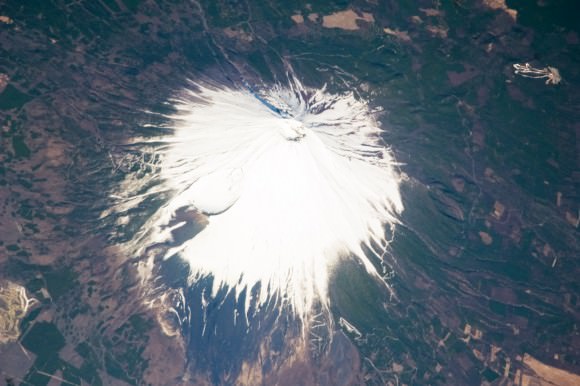
Mount Fuji, Japan’s tallest and most famous mountain, is an active volcano in the Ring of Fire. Mount Fuji last erupted in 1707, but recent earthquake activity in eastern Japan may have put the volcano in a “critical state.” Mount Fuji sits at a “triple junction,” where three tectonic plates (the Amur Plate, Okhotsk Plate, and Philippine Plate) interact.
The Ring of Fire’s eastern half also has a number of active volcanic areas, including the Aleutian Islands, the Cascade Mountains in the western U.S., the Trans-Mexican Volcanic Belt, and the Andes Mountains. Mount St. Helens, in the U.S. state of Washington, is an active volcano in the Cascade Mountains.
Below Mount St. Helens, both the Juan de Fuca and Pacific plates are being subducted beneath the North American Plate. Its historic 1980 eruption lasted 9 hours and covered 11 U.S. states with tons of volcanic ash. The eruption caused the deaths of 57 people, over a billion dollars in property damage, and reduced hundreds of square miles to wasteland.
Popocatépetl is one of the most active and dangerous volcanoes in the Ring of Fire, with 15 recorded eruptions since 1519. The volcano lies on the Trans-Mexican Volcanic Belt, which is the result of the small Cocos Plate subducting beneath the North American Plate. Located close to the urban areas of Mexico City and Puebla, Popocatépetl poses a risk to the more than 20 million people that live close enough to be threatened by a destructive eruption.

Earthquakes:
Scientists have known for some time that the majority of the seismic activity occurs along plate boundaries. Hence why roughly 90% of the world’s earthquakes – which is estimated to be around 500,000 a year, one-fifth of which are detectable – occur around the Pacific Rim, where multiple plate boundaries exist.
As a result, earthquakes are a regular occurrence in places like Japan, Indonesia and New Zealand in Asia and the South Pacific; Alaska, British Columbia, California and Mexico in North America; and El Salvador, Guatemala, Peru and Chile in Central and South America. Where fault lines run beneath the ocean, larger earthquakes in these regions also trigger tsunamis.
The most well-known tsumanis to take place in the Ring of Fire include the 2004 Indian Ocean earthquake and tsunami. This was the most devastating tsunami of its kind in modern times, killing around 230,000 people and laying waste to communities throughout Indonesia, Thailand, and Southern Asia.
In 2010, an earthquake triggered a tsunami which caused 4334 confirmed deaths and devastating several coastal towns in south-central Chile, including the port at Talcahuano. The earthquake also generated a blackout that affected 93 percent of the Chilean population.
In 2011, an earthquake off the Pacific coast of Tohoku led to a tsunami that struck Japan and led to 5,891 deaths, 6,152 injuries, and 2,584 people to be declared missing across twenty prefectures. The tsunami also caused meltdowns at three reactors in the Fukushima Daiichi Nuclear Power Plant complex.
The Ring of Fire is a crucial region for many reasons. It serves as one of the main boundary regions for the tectonic plates of over half of the globe. It also affects the lives of millions if not billions of people who live in these regions. For many of the people who live in the Pacific Ring of Fire, the reality of a volcanic eruption or earthquake is commonplace and a challenge they have come to deal with over time.
At the same time, the volcanic activity has also provided many valuable resources, such as rich farmland and the possibility of tapping geothermal activity for heating and electricity. As always, nature gives with one hand and takes with the other!
If you have enjoyed this article there are several others on Universe Today that you will find interesting. Here is one called 10 Interesting Facts About Volcanoes. There is also a great article about plate tectonics.
You can also find some good resources online. There is a companion site for the PBS program Savage Earth that talks about the Ring of Fire. You can also check out the USGS site to see a detailed map of the Pacific Ring of Fire and more detailed information about plate tectonics.
You can also listen to Astronomy Cast. Episode 141 talks about volcanoes.
What Is a Tsunami?

For people living in oceanfront communities, the prospect of a tsunami is a frightening one. Much like earthquakes, volcanoes, hurricanes and tornadoes, tsunamis are one of the most destructive natural forces on the planet. And much like these other phenomena, they require the right conditions to happen and are more common in some areas of the world than others.
Knowing how and when a tsunami will strike has therefore a subject of great interest for scientists over the ages. But for anyone who has lived in certain parts of the world where “tsunami zones” are common – namely Japan and the South Pacific – it is a matter of survival.
Definition:
Numerous terms are used in the English language to describe large waves created by the displacement of water, with varying degrees of accuracy. The term tsunami, for example, is literally translated from Japanese to mean “harbor wave”. There are only a few other languages that have an equivalent native word, though similar meanings can be found in Indonesia, Sri Lanka, and the Indian Subcontinent.
The term tidal wave has also been used, which is derived from the most common appearance of a tsunami – an extraordinarily high tidal bore. However, in recent years, the term “tidal wave” has fallen out of favor with the scientific community because tsunami actually have nothing to do with tides, which are produced by the gravitational pull of the moon and sun rather than the displacement of water.
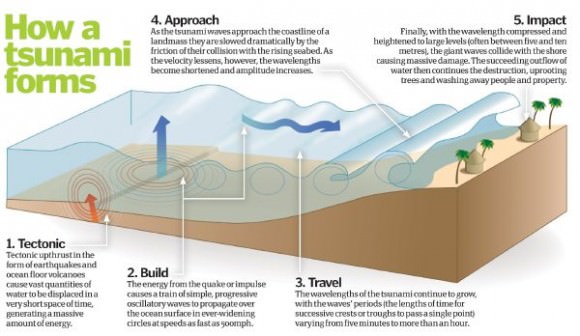
The term seismic sea wave also is used to refer to the phenomenon, due to the fact that the waves most often are generated by seismic activity such as earthquakes. However, like “tsunami,” “seismic sea wave” is not a completely accurate term, as forces other than earthquakes – including underwater landslides, volcanic eruptions, underwater explosions, land or ice slumping into the ocean, meteorite impacts, or even sudden changes in weather – can generate such waves by displacing water.
Causes:
The principal cause of a tsunami is the displacement of a substantial volume of water or perturbation of the sea. This is usually the result of earthquakes, landslides, volcanic eruptions, glacier calvings, or more rarely by meteorites and nuclear tests. The waves formed in this way are then sustained by gravity.
Tectonic earthquakes trigger tsunamis when the sea floor abruptly deforms and vertically displaces the water above. More specifically, a tsunami can be generated when thrust faults associated with convergent or destructive plate boundaries move abruptly and displace water.
Tsunamis have a small amplitude (wave height) offshore, and a very long wavelength (often hundreds of kilometers long), and only grow in height when they reach shallower water. Once there, the wavelength shortens as the wave encounters resistance, thus increasing the amplitude increases and causing the wave to rears up in a massive tidal bore.
In the 1950s, it was discovered that tsunamis larger than what had previously been believed possible could be caused by giant submarine landslides. These rapidly displace large water volumes, as energy transfers to the water at a rate faster than the water can absorb. Their existence was confirmed in 1958, when a giant landslide in Lituya Bay, Alaska, caused the highest wave ever recorded (524 meters/1700 feet).
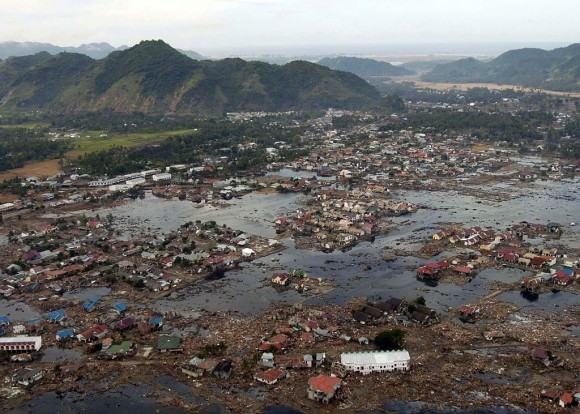
In general, landslides generate displacements mainly in the shallower parts of the coastline, such as in closed bays and lakes. But an open oceanic landslide large enough to cause a tsunami across an ocean has not yet happened since the advent of modern seismology, and only rarely in human history.
Meteorological phenomena, such tropical cyclones, can generate a storm surge that will cause sea levels to rise, often in coastal regions. These are what is known as meteotsunamis, which are tsunamis triggered by sudden changes in weather. When such tsunamis reach shore, they rear up in shallows and surge laterally, just like earthquake-generated tsunamis.
Tsunamis can also be triggered by external factors, such as meteors or human intervention. For instance, when a meteor of significant strikes a region of the ocean, the resulting impact is enough to displace high volumes of water, thus triggering a tsunami. There has also been much speculation since World War II of how a nuclear detonations have trigger a tsunami, but all attempts at research (especially in the Pacific) have yielded poor results.
Characteristics and Effects:
Tsunamis can travel at well over 800 kilometers per hour (500 mph), but as they approach the coast, wave shoaling compresses the wave and its speed decreases to below 80 kilometers per hour (50 mph). A tsunami in the deep ocean has a much larger wavelength of up to 200 kilometers (120 mi), but diminishes to less than 20 kilometers (12 mi) when it reaches shallow water.
When the tsunami’s wave peak reaches the shore, the resulting temporary rise in sea level is termed run up. Run up is measured in metres above a reference sea level. A large tsunami may feature multiple waves arriving over a period of hours, with significant time between the wave crests.
Tsunamis cause damage by two mechanisms. First, there is the smashing force of a wall of water traveling at high speed, while the second is the destructive power of a large volume of water draining off the land and carrying a large amount of debris with it.
It is often difficult for people to recognize a tsunami in the open ocean because the waves are much smaller further out at sea than they are close to shore. As with earthquakes, several attempts have been made to set up scales of tsunami intensity or magnitude to allow comparison between different events.
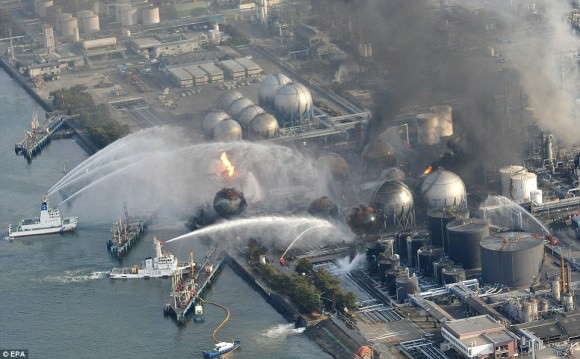
The first scales used routinely to measure the intensity of tsunami were the Sieberg-Ambraseys scale, used in the Mediterranean Sea and the Imamura-Iida intensity scale, used in the Pacific Ocean. This latter scale was modified by Soloviev to become the Soloviev-Imamura tsunami intensity scale, which is used in the global tsunami catalogs compiled by the NGDC/NOAA and the Novosibirsk Tsunami Laboratory as the main parameter for the size of the tsunami.
In 2013, following the intensively studied tsunamis in 2004 and 2011, a new 12 point scale was proposed, known as the Integrated Tsunami Intensity Scale (ITIS-2012). This scale was intended to match as closely as possible to the modified ESI2007 and EMS earthquake intensity scales.
Tsunamis throughout History:
Japan and the Pacific Ocean may have the longest recorded history of tsunamis, but they are an often underestimated hazard in the Mediterranean Sea region and Europe in general. In his History of the Peloponnesian War (426 BCE), Greek historian Thucydides offered what could be considered the first recorded speculation about the causes of tsunamis – where he argued that earthquakes at sea were the reason for them.
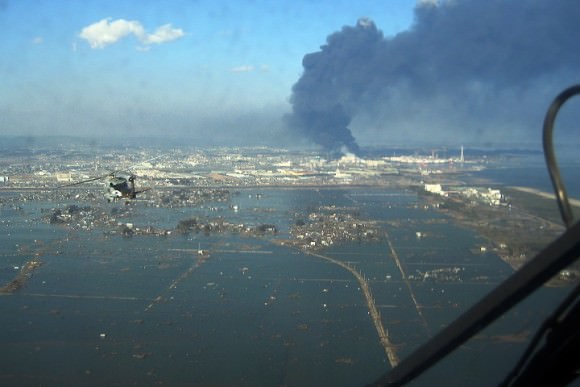
After the tsunami of 365 CE devastated Alexandria, Roman historian Ammianus Marcellinus described the typical sequence of a tsunami. His descriptions included an earthquake and the sudden retreat of the sea, followed by a gigantic wave.
More modern examples include the 1755 Lisbon earthquake and tsunami (which was caused by activity in the Azores–Gibraltar Transform Fault); the 1783 Calabrian earthquakes, which caused several ten thousand deaths; and the 1908 Messina earthquake and tsunami – which caused 123,000 deaths in Sicily and Calabria and is considered one of the most deadly natural disasters in modern European history.
But by far, the 2004 Indian Ocean earthquake and tsunami was the most devastating of its kind in modern times, killing around 230,000 people and laying waste to communities throughout Indonesia, Thailand, and Southern Asia.
In 2010, an earthquake triggered a tsunami which devastated several coastal towns in south-central Chile, damaged the port at Talcahuano and caused 4334 confirmed fatalities. The earthquake also generated a blackout that affected 93 percent of the Chilean population.
In 2011, an earthquake off the Pacific coast of Tohoku led to a tsunami that struck Japan and led to 5,891 deaths, 6,152 injuries, and 2,584 people to be declared missing across twenty prefectures. The tsunami also caused meltdowns at three reactors in the Fukushima Daiichi Nuclear Power Plant complex.
Tsunamis are a force of nature, without a doubt. And knowing when, where, and how severely they will strike is intrinsic to ensuring that we can limit the damage they do cause.
Universe Today has articles on about tsunamis and causes of tsunamis.
For more information, try tsunami and causes of tsunamis.
Astronomy Cast has an episode on Earth.
Source:
Wikipedia
Massive Earthquake off the Coast of Chile Triggers Tsunami Warnings in the Pacific
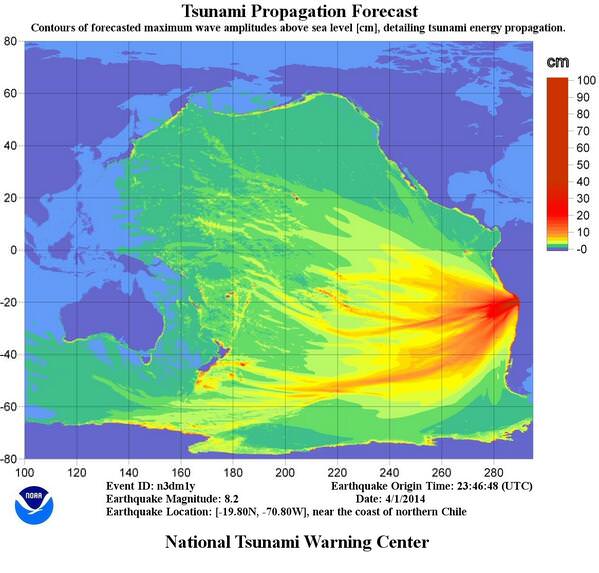
An 8.2-magnitude earthquake off the coast of northern Chile on April 1, 2014 was followed by at least a dozen significant aftershocks, including one with a magnitude of 6.2. This activity initially generated tsunami warnings across the Pacific, but the warnings were later canceled except for the coastal regions of Chile and Peru, according to NOAA’s Pacific Tsunami Warning Center.
Tsunami waves of more than 2 meters (6 feet) came ashore on the coast of Pisagua, Chile and 2.13 meter (7-foot) waves were reported in Iquique, Chile, according to the PTWC. The U.S Geological Survey reported the quake major quake was centered offshore about 96 km (60 miles) northwest of Iquique, at a depth of 20 km (12.5 miles).
At the time of this writing, the quake has reportedly caused only minor damage in Chile with two possible casualties, but several people are missing. There was a small landslide, several large fires, along with damaged boats and some flooding in Iquique due to the tsunami, according to Earthquakereport.com.
Chile’s National Emergency Office tweeted Tuesday night that it was asking everyone to evacuate the country’s coastal areas, and reports in the news and on social media said that the evacuations were orderly.
This earthquake follows several weeks of seismic activity in the South American Pacific region. On March 16, a 6.7-magnitude earthquake struck 60 km (37 miles)northwest of Iquique, according to the USGS. A 6.1-magnitude hit the same area one week later.
Chile is one of the most seismically active countries in the world, and is along the so-called “Ring of Fire,” an arc of volcanoes and fault lines circling the Pacific Basic that is prone to frequent earthquakes and volcanic eruptions.
The strongest earthquake ever recorded on Earth also took place happened in Chile. A magnitude-9.5 quake in 1960 killed more than 5,000 people. The most recent large quake in February 2010 hit central and southern Chile with a magnitude of 8.8, followed by a tsunami that left more than 500 dead with $30 billion in damage to property.
Tsunami waves travel about 800 km per hour, (500 miles per hour). That seems fast, but compared to a seismic wave it is slow. The speed of seismic wave, the P wave (or primary wave, which is the fastest kind of seismic wave) is about 8 km per second, or 30,000 km per hour.
You can compare a tsuanmi wave to the speed of a jet plane.
But while scientists can predict the speed and the direction of tsunamis fairly well, the height at a given location is can be very hard to predict, according to Anne Sheehan from the University of Colorado at Boulder, who spoke to Universe Today for a previous article about the science behind a tsunami.
“For predicting an ensuing tsunami, to have data on the earthquake itself — getting its epicenter located and knowing its size as accurately as possible plays a big role,” she said, “and the USGS plays a big role in getting that information out as quickly as possible.
Update: Here’s an animation from NOAA of the prediction of the tsunami following the April 1 quake in Chile:
Tsunami Watch in Effect after Massive Earthquake off the Coast of Indonesia
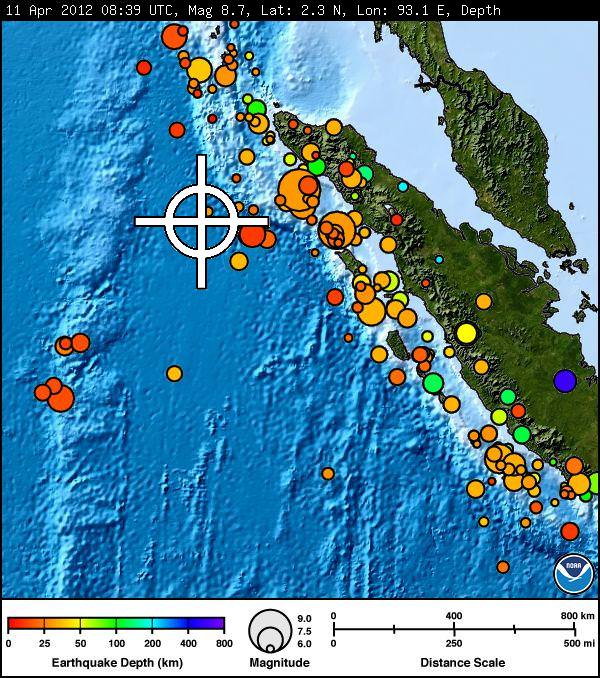
[/caption]
Update: Good news: The latest bulletin from the Pacific Tsunami Warning Center, as of 13:00 UTC has canceled the tsunami watch. See here fore more details.
An Indian-ocean-wide tsunami watch is in effect after a massive earthquake off the coast of Indonesia. The quake had a preliminary magnitude of 8.7, and the U.S. Geological Survey said it was centered 32 km (20 miles) beneath the ocean floor about 191 km (308 miles) from the provincial capital of Banda Aceh, the westernmost province in Indonesia. Major aftershocks have occurred, some with magnitudes as high as 8.3.
The tsunami watch area is now reduced from the first reports, as the USGS said the earthquake “moved horizontally, not vertically” but initially included Indonesia, India, Sri Lanka, the Maldives and parts of the UK. A tsunami watch means there is the potential for a tsunami, not that one is imminent.
The earthquake took place at 08:39 UTC on April 11, at 2.3 degrees north and 93.1 degrees east, off the west coast of Northern Sumatra. Reports from Reuters and AP now say that although measurable, the tsunami “does not look major,” officials said.
The Washington Post reported early after the initial quake that a wave measuring less than 30 inches (80 centimeters) high, rolled to Indonesia’s coast, and first reports said there were no other signs of serious damage. But then an 8.2-magnitude aftershock hit, and another tsunami warning was issued, and people along the western coast of Sumatra island and the Mentawai islands were told to stay clear of coasts.
The latest from the Pacific Tsunami Warning Center reports these measurements for tsunami wave activity:
GAUGE LOCATION LAT LON TIME AMPL PER
——————- —– —— —– ————— —–
TRINCONMALEE LK 8.6N 81.2E 1116Z 0.04M / 0.1FT 18MIN
COCOS ISLAND AU 12.1S 96.9E 1102Z 0.08M / 0.3FT 18MIN
TELUKDALAM ID 0.6N 97.8E 1045Z 0.19M / 0.6FT 10MIN
SABANG ID 5.8N 95.3E 1010Z 0.36M / 1.2FT 06MIN
MEULABOH ID 4.1N 96.1E 1007Z 1.06M / 3.5FT 12MIN
DART 23401 8.9N 88.5E 0956Z 0.03M / 0.1FT 06MIN
We’ll provide more information as it becomes available.
Equipment to Study Hayabusa’s Asteroid Samples Damaged in Japan Earthquake
[/caption]
The large particle accelerator being used in to analyze the asteroid samples returned by the Hayabusa spacecraft was damaged by the March 11 earthquake in Japan, but the high energy accelerator at the KEK particle-physics laboratory will be repaired, according to this report on a Japanese website. An announcement on the KEK website said that all accelerators and experimental devices were stopped immediately “after the first shake” of the historic earthquake. “We have confirmed the radiation safety, and no hazard to the environment has been reported,” the announcement said. “Also there are no reports of casualties on both Tsukuba and Tokai campuses.” Tsukuba is in the mid-latitudes of Japan, about 50 km from Tokyo.
Apparently, the tiny asteroid particles are safe, but an official at KEK was quoted as saying (via Google Translate) “The accelerator needs to be adjusted very precisely. To suffer this much, but it takes time to recover, want to lose to the earthquake recovery.”
But the repairs to the accelerator may take a back seat to the current situation in Japan. The city of Tsukuba is going to take in refugees from Fukushima prefecture, where the heavily damaged nuclear reactor is located and the KEK facilities will provide support for radiation screening for the refugees upon their arrival.
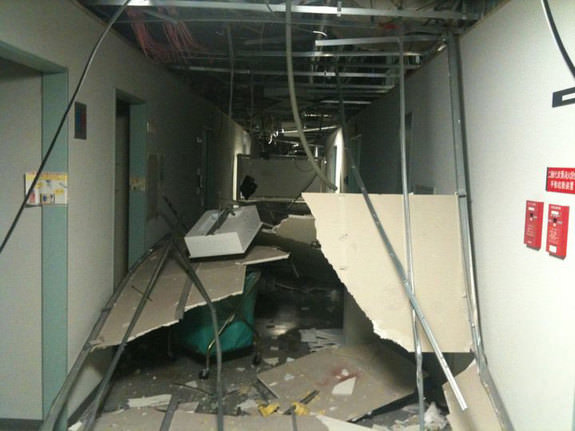
Tsukuba is also home to the space center that oversees Japan’s Kibo laboratory on the International Space Station, as well the JAXA’s unmanned cargo ships that deliver supplies on orbit. The space center was slightly damaged, and for awhile NASA’s Mission Control in Houston took over operations remotely. According to Robert Pearlman on collectSPACE, several of the Japanese flight control team members and flight directors from the Tsukuba Space Center happened to be in Houston when the quake struck, preparing for the Expedition 27 crew rotation, as astronaut Satoshi Furukawa will be heading the ISS in May. However, operations from the mission control rooms were resumed at 4:00 p.m. on March 22, 2011.
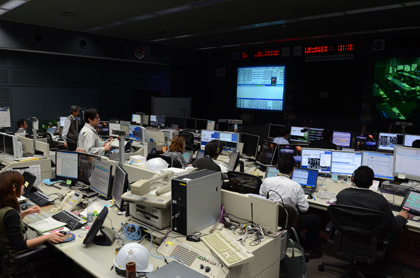
Another center, the Kakuda Space Center, located in the Miyagi region close to the most serious effects of the earthquake and tsunami, was heavily damaged, and is closed with no timetable for reopening. The Kakuda center is JAXA’s rocket development and testing center and is Japan’s equivalent of the Stennis Space Center in Mississippi.
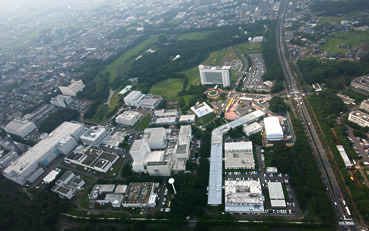
Additionally, the ground-breaking ceremony for a new type of particle smasher known as a “super B factory” in Tsukuba has been postponed. Japan had invested $100 million to transform the KEKB collider in Tsukuba, into a Super KEKB, which will smash electrons into positrons at 40 times the rate of the current accelerator.
Just before the quake, the Japanese Space Agency JAXA had announced they are planning a second Hayabusa mission with an explosive twist. The second mission to an asteroid probe will include an impactor that detonates an explosive on the asteroid’s surface, similar to the Deep Impact mission.
The launch was tentatively planned for launch in 2014, heading to a space rock catalogued as 162173 1999 JU3. The probe would land on the surface and, collect samples before and after the impactor blasts its way to the asteroid’s interior.
Despite the problems Hayabusa encountered along its arduous journey to and from asteroid Itokawa –including thruster, communications, gyro and fuel-leak problems, as well as uncertainty whether the probe landed on the asteroid – JAXA and the Japanese people were buoyed by the success of Hayabusa.
It is not clear how the tragic earthquake and tsunami will affect future space missions for Japan, but obviously the country has more important issues ahead of them. May the spirit of the Japanese people be lifted again.
Sources: NHK,, KEK , collectSPACE, Moon and Back, JAXA
Hat tip to Emily Lakdawalla via Twitter.
Satellite Photos Before and After of Japan’s Earthquake, Tsunami
[/caption]
Photos from the GeoEye satellite imaging company from before and after the March 11 earthquake and tsunami in Japan show sobering views from above of the disaster. Above is the town of Sendai, Japan after the quake, below is how it looked before catastrophe struck.
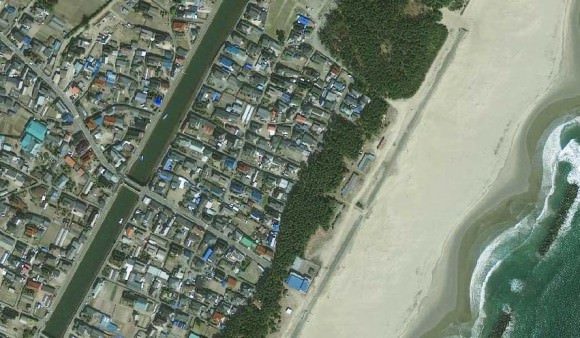
See more below.
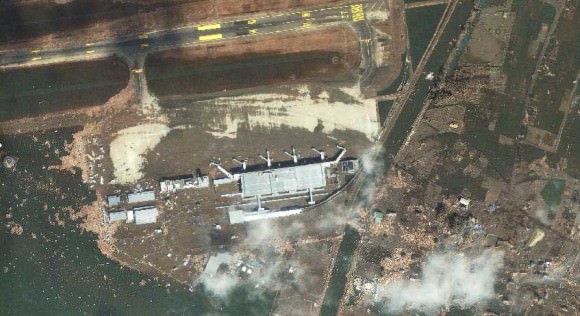
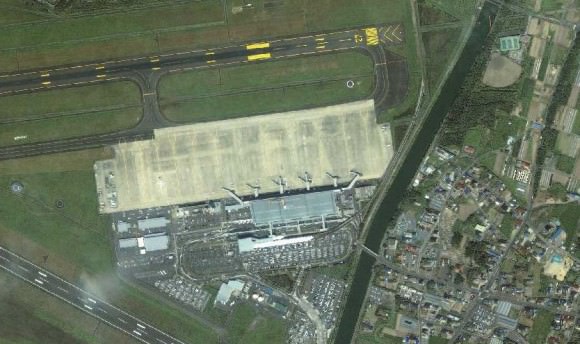
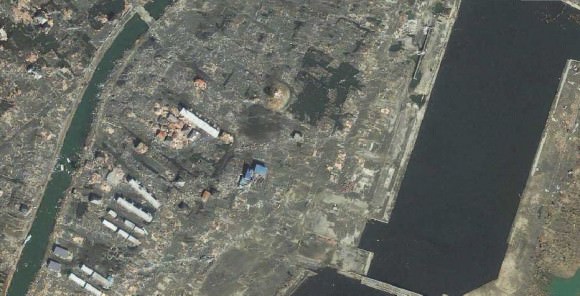
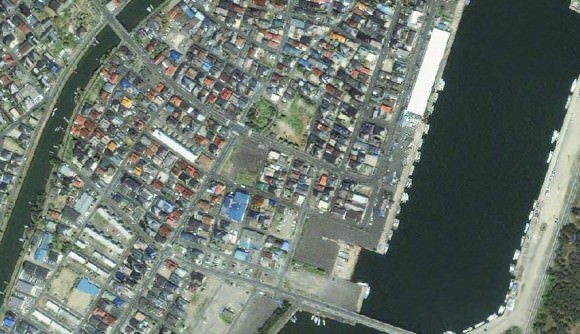
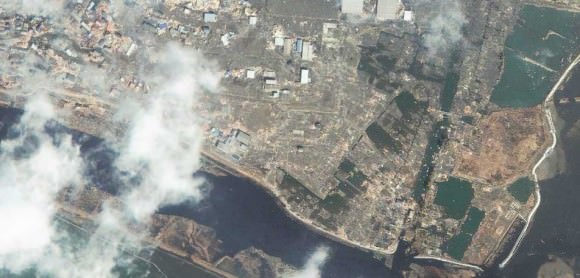
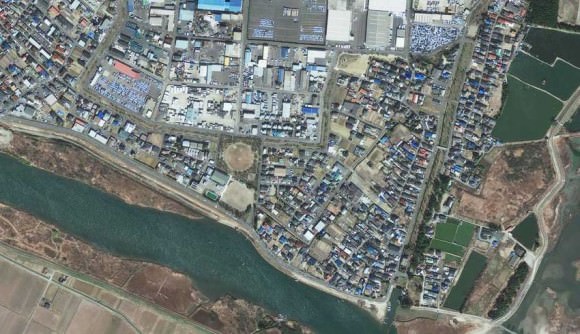
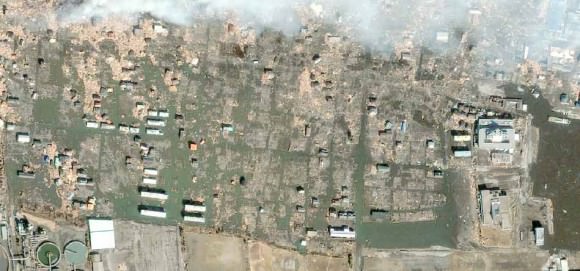
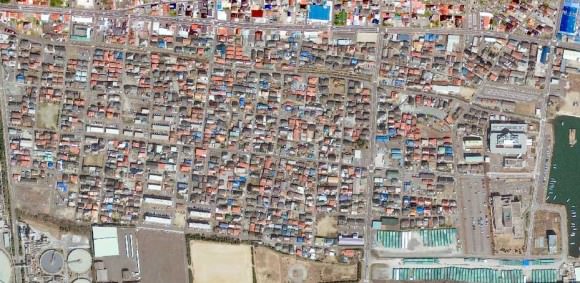
Below is an images from the MODIS Rapid Response System, which is producing twice-daily images of Japan in response to the disaster.
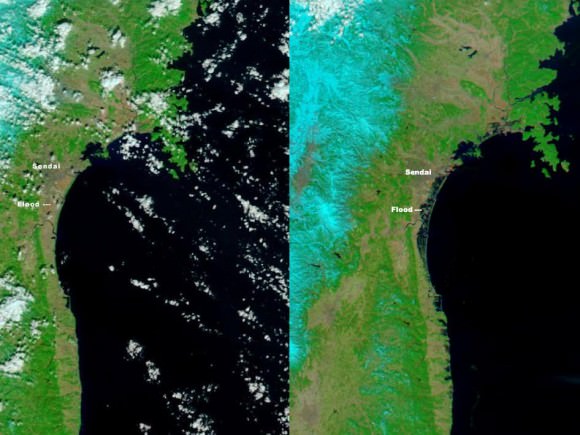
These two images, from the MODIS instrument on NASA’s Aqua satellite from Mar. 13, 2011 on the right, and the the MODIS sensor on NASA’s Terra satellite from Feb. 26, 2011 on the left before the earthquake and tsunami. Both images were made with infrared and visible light to highlight the presence of water on the ground. Plant-covered land is bright green, bare earth is tan-pink, and snow is blue. The city of Sendai is brown.
At this level of detail, the flooding along the coastline is the most obvious sign of the destructive earthquake and tsunami that struck Japan on March 11. A bright orange-red spot near the city of Sendai is the thermal signature from a fire, also likely caused by the earthquake. The photo-like true-color version of the image shows a plume of black smoke extending east over the ocean.
The German Aerospace Center (Deutsches Zentrum fur Luft- und Raumfahrt; DLR) is responding through its Center for Satellite Based Crisis Information (Zentrum fur Satellitengestutzte Kriseninformation; ZKI), based at its site in Oberpfaffenhofen, and provided the image below.
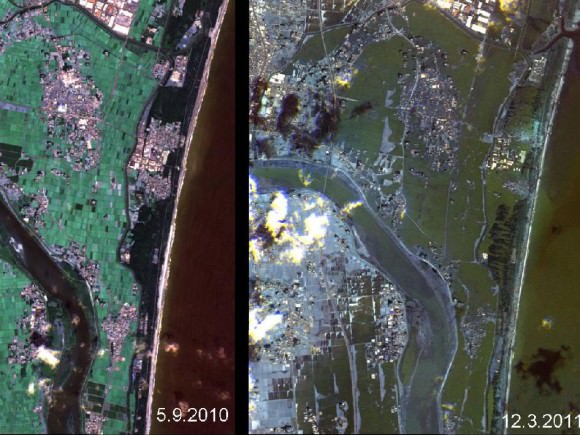
Sources: GeoEye, New York Times, NASA, Space Daily
Just to be Clear: The Moon Did Not Cause the Earthquake in Japan
[/caption]
We’re getting a lot of visitors to our site today, many searching for information about earthquakes, tsunamis, and the ‘SuperMoon’ phenomenon. Just to be clear, the Moon did not cause the earthquake in Japan. Several scientists have posted articles online today clarifying the topic, and all of them, in no uncertain terms, agree that the the upcoming perigee of the Moon — where it is closer than usual in its orbit to Earth — had nothing to do with the earthquake and ensuing tsunami. Tammy discussed this yesterday, but as we often do, we’ll also point you in the direction of an article by astronomer Phil Plait about this topic, and another by Ben Goldacre, who completely debunks an article that appeared in the Daily Mail about the possibility of a connection between the two events.
In addition, Dr. Jim Garvin, chief scientist at NASA’s Goddard Space Flight Center, has provided some answers to questions about the ‘supermoon’ phenomenon, below:
Question: What is the definition of a supermoon and why is it called that?
Garvin: ‘Supermoon’ is a situation when the moon is slightly closer to Earth in its orbit than on average, and this effect is most noticeable when it occurs at the same time as a full moon. So, the moon may seem bigger although the difference in its distance from Earth is only a few percent at such times.
It is called a supermoon because this is a very noticeable alignment that at first glance would seem to have an effect. The ‘super’ in supermoon is really just the appearance of being closer, but unless we were measuring the Earth-Moon distance by laser rangefinders (as we do to track the LRO [Lunar Reconnaissance Orbiter] spacecraft in low lunar orbit and to watch the Earth-Moon distance over years), there is really no difference. The supermoon really attests to the wonderful new wealth of data NASA’s LRO mission has returned for the Moon, making several key science questions about our nearest neighbor all the more important.
Question: Are there any adverse effects on Earth because of the close proximity of the moon?
Garvin: The effects on Earth from a supermoon are minor, and according to the most detailed studies by terrestrial seismologists and volcanologists, the combination of the moon being at its closest to Earth in its orbit, and being in its ‘full moon’ configuration (relative to the Earth and sun), should not affect the internal energy balance of the Earth since there are lunar tides every day. The Earth has stored a tremendous amount of internal energy within its thin outer shell or crust, and the small differences in the tidal forces exerted by the moon (and sun) are not enough to fundamentally overcome the much larger forces within the planet due to convection (and other aspects of the internal energy balance that drives plate tectonics). Nonetheless, these supermoon times remind us of the effect of our ‘Africa-sized’ nearest neighbor on our lives, affecting ocean tides and contributing to many cultural aspects of our lives (as a visible aspect of how our planet is part of the solar system and space).
Massive 8.9 Earthquake Hits Japan; Tsunamis Predicted for Pacific Basin
[/caption]
An 8.9-magnitude earthquake struck off the coast of northern Japan on March 11, one of the strongest to ever hit Japan. The massive quake has triggered tsunamis not only in Japan, but around the Pacific Basin. Walls of water and debris have inundated coastal areas of Japan, and tsunami warnings were issued for at least 20 countries and numerous Pacific islands, including coastal Russia, the western coast of Canada and the US, the Marcus Islands, Taiwan, Guam and the Hawaiian Islands, where a full coastal evactuation has been taking place throughout early Friday morning. Strong aftershocks, as strong as 6.5-magnitude continue to shake the region, (the latest U.S. Geological Survey map, above, shows 95 recent quakes in the area) and at least one nuclear power plant in Japan may be encountering problems. Images coming from Japan show widespread damage from both the quakes and the tsunamis.
The USGS reported that the epicenter of the earthquake was 373 kilometers (231 miles) northeast of Tokyo and 130 km (80 miles) east of Sendai, Honshu. Police reports from Sendai say that so 200-300 bodies have been recovered, but the total death toll will likely be much, much higher. Reports say this is the 6th largest earthquake ever monitored, and the largest in Japan in over 140 years.
Tokyo did not suffer much damage, but in northern Japan, many areas were devastated. Compounding the damage was a wall of water that rushed inland of the island nation, leveling houses and washing away boats, cars and other debris. Click here to see some shocking images from the New York Times.
Reports says Japan is evacuating thousands of people from nearby a nuclear power plant, but the current condition of the reactor core is unknown at this time. Four reactors are located near the Earthquake area. The reactors were shut down, and no leaks have been found so far, but the cooling system for the reactors may not be working correctly.
Reports via Twitter say the roof may have collapsed at JAXA Tsukuba Space Center.
Tsunami waves have now begun to wash ashore in the Hawaiian Islands. The first waves are not necessarily the strongest; waves are predicted to be 2-3 meters (6-8 ft.) in Hawaii. Tsunamis are very hard to predict, and the USGS says wave heights can vary widely.
Get the latest on the tsunami predictions from NOAA’s Pacific Tsunami Warning Center.
See this Google Map, overlaid with NOAA-predicted tsunami times.
Callan Bentley at the AGU Blogosphere has a good overview of earthquake and tsunami dynamics.
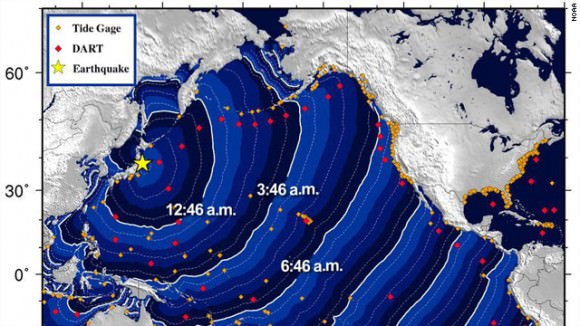
What Causes Earthquakes?
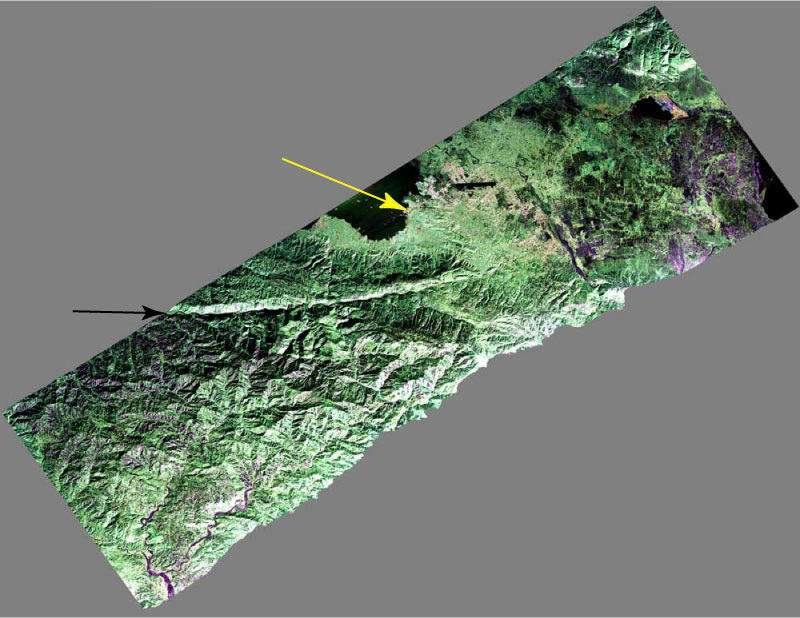
The two main answers to ‘how earthquakes happen’ is: as a result of tectonic plates colliding and volcanic eruption. The shock waves associated with nuclear weapons testing and other man-made explosions. To be considered an earthquake a shock wave has to be of natural origin.
Earthquakes Caused By Tectonic Plates:
The theory of plate tectonics explains how the crust of the Earth is made of several plates, large areas of crust which float on the Mantle. Since these plates are free to slowly move, they can either drift towards each other, away from each other or slide past each other. Many earthquakes happen in areas where plates collide or slide past each other. The Elastic Rebound Theory applies to these quakes.
Major earthquakes are sometimes preceded by a period of changed activity. This might take the form of more frequent minor shocks as the rocks begin to move,called foreshocks, or a period of less frequent shocks as the two rock masses temporarily ‘stick’ and become locked together. Following the main shock, there may be further movements, called aftershocks, which occur as the rock masses settle into their new positions. Aftershocks cause problems for rescue services because they can bring down buildings that were weakened by the main quake.
Earthquakes Caused By Volcanoes:
Volcanic earthquakes are far less common than tectonic plate related ones. They are triggered by the explosive eruption of a volcano. When a volcano explodes the associated earthquake effects are usually confined to an area 16 to 32 km around its base.
The volcanoes which are most likely to explode violently are those which produce acidic lava. Acidic lava cools and sets very quickly when it contacts air. This chokes the volcano’s vent and blocks the escape of pressure. The only way a blockage can be removed is by the pressure building up until it literally explodes the blockage outward.
The volcano will explode in the direction of its weakest point, so it is not always upward. Extraordinary levels of pressure can produce an earthquake of considerable magnitude. The shock waves have been known to produce a series of tsunami in some instances.
There you have the answer to ‘how earthquakes happen’. Keep in mind that there have been man-made shock waves following large explosions, but they are not considered earthquakes because of their artificial origin.
We have written many articles about earthquakes for Universe Today. Here’s an article about the biggest earthquake, and here are some pictures of earthquakes.
If you’d like more info on earthquakes, check out the U.S. Geological Survey Website. And here’s a link to NASA’s Earth Observatory.
We’ve also recorded related episodes of Astronomy Cast about Plate Tectonics. Listen here, Episode 142: Plate Tectonics.
Sources:
http://earthquake.usgs.gov/learn/topics/plate_tectonics/rift_man.php
http://www.geo.mtu.edu/UPSeis/where.html
http://www.geo.mtu.edu/volcanoes/hazards/primer/eq.html
http://news.discovery.com/earth/are-volcanoes-and-earthquakes-related.html

